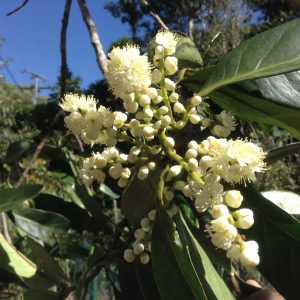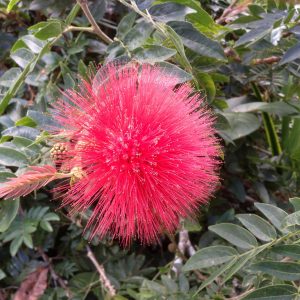WHITE HAZELWOOD Simplocos chinchinensis
 When in bloom, usually any time from April through June, the White Hazelwood tree (Simplocos chinchinensis,) is eye-catching crowned with a dense display of fluffy, white flower panicles. The flowers have a delicate fragrance and attract insects and birds. One of these trees is at present (early June) in full bloom and may be seen at the southern gate of the High Ropes course. There are several of these trees scattered around the village and along the sides of the Ridge Road near Paluma. Not all are yet in bloom.
When in bloom, usually any time from April through June, the White Hazelwood tree (Simplocos chinchinensis,) is eye-catching crowned with a dense display of fluffy, white flower panicles. The flowers have a delicate fragrance and attract insects and birds. One of these trees is at present (early June) in full bloom and may be seen at the southern gate of the High Ropes course. There are several of these trees scattered around the village and along the sides of the Ridge Road near Paluma. Not all are yet in bloom.
Symplocos is one genus with approximately 250 species around the world and in Australia, there are 15 to 20. Wendy Cooper, in “Fruits of the Australian Tropical Rainforest’ lists 17 species which occur in tropical Queensland. The tree can grow to about 30 meters high.


The tree is not easily identifiable by its trunk and lower branches which have lightly textured bark. Like so many rainforest trees, the bark is mottled with lichen, camouflaging the surface with splotches of white, tan and green. The leaves however are distinctive. Mature leaves are elliptic in shape, are leathery and a dark, almost black, green and can be 70 -200 mm long and 7 -25 mm wide. Veins are well defined, giving the leaf an almost quilted appearance and the underside has a prominent purple mid-rib.
The flowers are tiny, with 5 white petals and many long filamentous stamens which when clustered in panicles, give a soft fluffy appearance. Unfortunately their beauty can be appreciated for only a few weeks – usually rain and wind dash them from the tree to form a carpet of white on the ground below.
The fruits of White Hazelwood are small, fleshy, olive-shaped blue/black drupes, 6 -10 mm long containing one or two seeds within a woody endocarp. The fruit ripens between November and March and is eaten by many bird species.
Keep an eye open over the next month or two for these lovely trees.
Text and Photos by Colwyn Campbell




 Calliandra haematocephala is a species of the Genus Calliandra, in the Fabaceae Family (pea family) and came originally from South America. It is sometimes called the Fairy Duster or the Tassel Flower. The tree grows to about 3 metres high and has rather a straggly appearance. However when it blooms it is a beautiful sight, covered with soft red powder-puff flowers which attract insects and birds. The Eastern Spinebill is a regular visitor to the flowers.
Calliandra haematocephala is a species of the Genus Calliandra, in the Fabaceae Family (pea family) and came originally from South America. It is sometimes called the Fairy Duster or the Tassel Flower. The tree grows to about 3 metres high and has rather a straggly appearance. However when it blooms it is a beautiful sight, covered with soft red powder-puff flowers which attract insects and birds. The Eastern Spinebill is a regular visitor to the flowers. Red Hot Poker
Red Hot Poker The Scrub Ironwood is a member of the Myrtaceae family; Genus – Gossia, Species – bidwillii.
The Scrub Ironwood is a member of the Myrtaceae family; Genus – Gossia, Species – bidwillii.
 The black bat plant (Tacca chantrieri) is an unusual exotic plant that is native to tropical Asia. It grows well at Paluma, most often as a pot plant in a protected shaded position away from direct sunlight. The large flowers are striking and resemble a bat in flight. The flowers are black to deep purple with ruffled edges and long, hanging filaments. Large bright green leaves surround the bloom. Several gardeners at Paluma have spectacular specimens of the black bat plant. It flowers all year round, but seems to produce most flowers during the summer months.
The black bat plant (Tacca chantrieri) is an unusual exotic plant that is native to tropical Asia. It grows well at Paluma, most often as a pot plant in a protected shaded position away from direct sunlight. The large flowers are striking and resemble a bat in flight. The flowers are black to deep purple with ruffled edges and long, hanging filaments. Large bright green leaves surround the bloom. Several gardeners at Paluma have spectacular specimens of the black bat plant. It flowers all year round, but seems to produce most flowers during the summer months. The White Bat Plant (Tacca integrifolia) is a member of the yam family Dioscoreaceae. It is native to hilly regions of tropical and subtropical Asia where it thrives in the in the shady and humid understorey of the rainforest. The long, flowing ‘whiskers’ of this flower can grow to 30 cm long.
The White Bat Plant (Tacca integrifolia) is a member of the yam family Dioscoreaceae. It is native to hilly regions of tropical and subtropical Asia where it thrives in the in the shady and humid understorey of the rainforest. The long, flowing ‘whiskers’ of this flower can grow to 30 cm long. If you take a stroll through the village of Paluma between April to May you are likely to see several beautiful specimens of the Gordonia plant in full bloom. Gordonia axillaris is an exotic shrub or small tree which is a close relative to the camellia. Although Gordonia’s are slow-growing they are well suited to the cool mountain climate at Paluma. You will recognise the Gordonia from its spectacular large white blooms with bright yellow stamens. The flowers tend to fall from the tree with their egg-yolk yellow stamens facing upwards. At first glance this has the appearance of fried eggs lying around the base of the plant. For this reason, the Gordonia is often referred to by its common name, the “fried egg plant”. Gordonia’s are a great attractant for both native bees and exotic bees. Keep an eye out for the “fried egg plant” in several gardens as you walk along Mt Spec Road.
If you take a stroll through the village of Paluma between April to May you are likely to see several beautiful specimens of the Gordonia plant in full bloom. Gordonia axillaris is an exotic shrub or small tree which is a close relative to the camellia. Although Gordonia’s are slow-growing they are well suited to the cool mountain climate at Paluma. You will recognise the Gordonia from its spectacular large white blooms with bright yellow stamens. The flowers tend to fall from the tree with their egg-yolk yellow stamens facing upwards. At first glance this has the appearance of fried eggs lying around the base of the plant. For this reason, the Gordonia is often referred to by its common name, the “fried egg plant”. Gordonia’s are a great attractant for both native bees and exotic bees. Keep an eye out for the “fried egg plant” in several gardens as you walk along Mt Spec Road.


